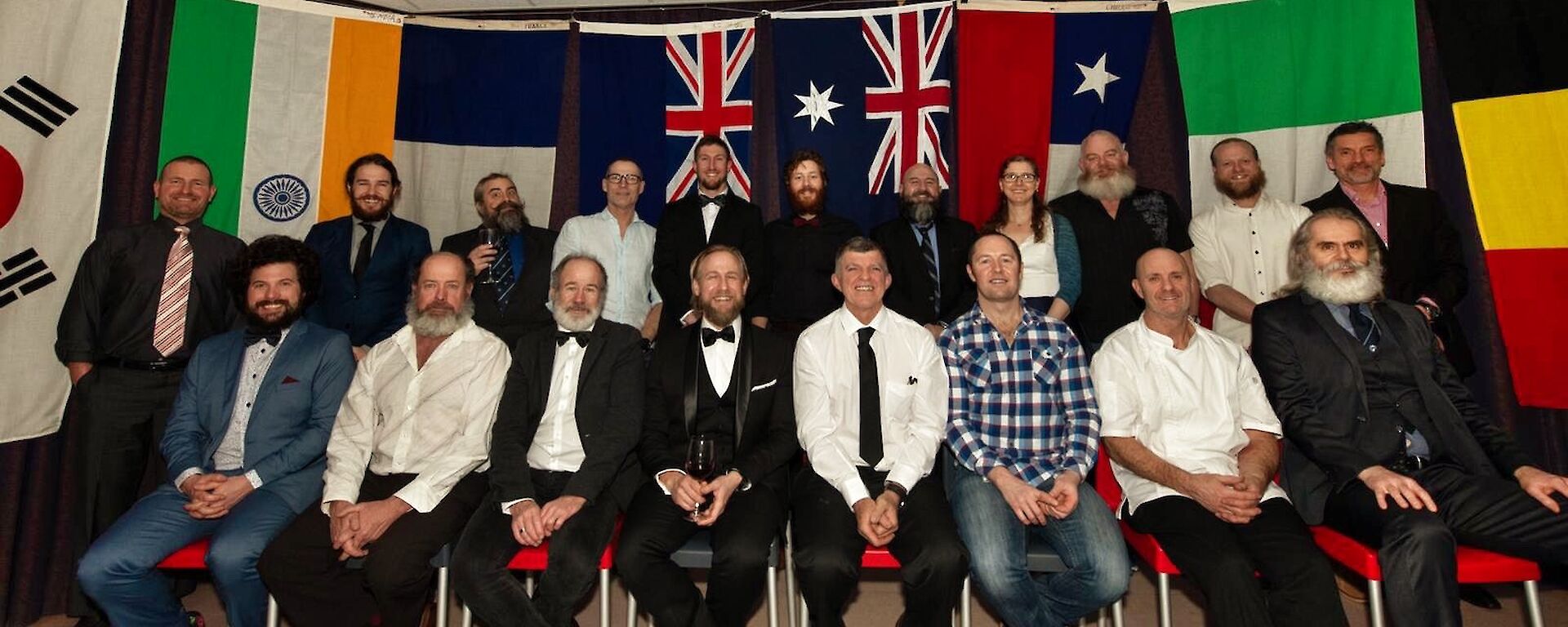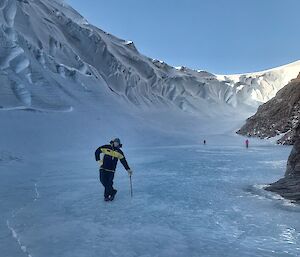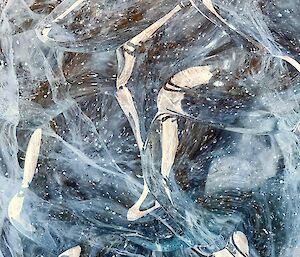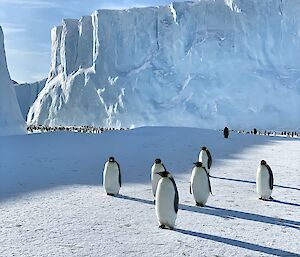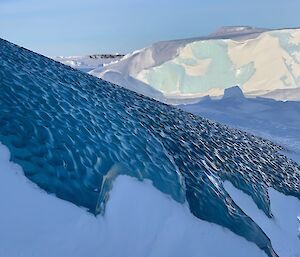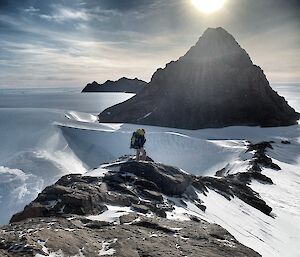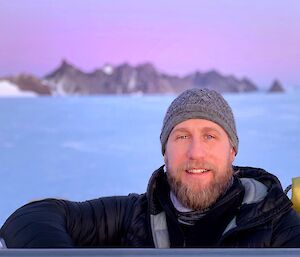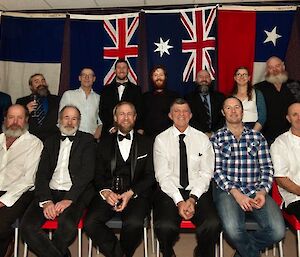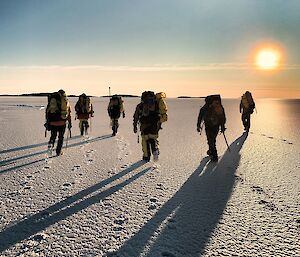Family, friends and strangers alike share a common challenge – picturing what life has been like here for this group of motley Antarctic inhabitants, beyond a full rotation around the sun. And it is incredibly hard to imagine. It is even harder to describe. I often wonder if we even have the vocabulary to render it possible. I recall hearing stories of Inuit tribes having around 100 words for snow; and there being over 96 words for love in Sanskrit. Maybe that is part of our challenge. Maybe it is that two dimensions in a picture only offer a tantalising glimpse, absent of depth and accompanying sounds, temperature and smells.
Absent a specific Antarctic lexicon, I’ll outline one perspective on what it is to experience an endless winter on the edges of the world, clinging to the fringes of human capability and survival, with the most diverse gang you could imagine.
In essence there is a magic to it all… to the place…to its inhabitants.
The moment I looked out my cabin window on the Aurora Australis, gazing upon this place, I knew that words and even pictures would fail to describe what I was about to experience. And I loved it. I was about to step, literally, into the unknowable.
The magic of this place, of Mawson station environs, is jaw-dropping. There was something alien about the world I was attempting to process with my eyes; this place that was burning my skin with its cold breath and unfiltered sunlight.
The station itself appears as a clumsy set of colourful lego blocks placed randomly upon one of the tiny rock fingers protruding from a white wall behind it. While the station architecture and engineering was interesting to see, it was really what surrounds the station that was mind boggling. It is as if a tidal wave of ice, kilometres high, is magically split by these miniscule rocks on its edge…and the wave breaks on either side of the station, plunging into the incredibly deep ocean that bounds the pin-pricks of rock. Jagged, broken and fracturing ice cliffs are the waterfalls of Antarctica, rolling off this immense continental sized dome of ice – and they stretch as far as your mind will imagine, in every direction. While it takes thousands of years to move, this water still moves with such an obvious strength and ferociousness that it seems nothing could stand in its way. It truly is amazing to see this tiny brown dot of rock almost entirely engulfed, but spared, from this incredible force of nature. Close your eyes, and imagine a biblical tale where unimaginably tall tidal waves engulf the land – winding, swirling and violently crashing over everything in its path – with a small house on a hill miraculously spared the fate of the world around it. That is Mawson station…somehow spared by its geology, or by magic, from the ocean of ice crashing into the sea of water around it.
And as the shade began to fall on that first night, another magical force began to rumble, coming from the same direction – also seemingly eager to force this station from its fragile foothold. Katabatic winds that are only experienced in Antarctica, are a twist of nature and physics that is still difficult to fathom. Gale force winds that prowl the lands only at night, born of unique polar physics on the mysterious white mountain of ice behind, fed by gravity, and rushing down to crash into the sea. If you could see it, it too would appear as a wave generated from the bottom of the earth – a furious frozen dragon's breath that stirs only in the late hours of each day. Even the wind plays by different rules here.
Home was clearly bound to be a place of magic, mystery and alien beauty – forces of which exist nowhere else on our planet.
And I was to find more magic here – a lot more.
First it was the inhabitants. We weren’t strangers, having trained and eaten together for weeks before this adventure. But we also did not know each other as expeditioners, here, in this place. It didn’t take long to be blown away by this little ecosystem of misfits and wanderers. While the best in craft across a wide spectrum of professions, it takes a very special kind of character to apply for and follow through with, a deployment to Antarctica. The unknowns and the knowns – the certain risk and discomfort, the isolation from loved ones and from convenience, the inescapable intimacy and proximity to strangers, the monotony and claustrophobia of our tiny station footprint and limits imposed by the weather – and no way to escape, for at least a full year. Who chooses that?! Well it soon becomes obvious that some incredible, resilient, talented, hilarious and gregarious souls do. The magic goes beyond the brave and talented individuals who come here – the most incredible aspect is undoubtedly the magic ‘between’ those folk. A diplomat, three chippies, two plumbers, two sparkies, a unicorn plumber/sparky, two meteorological professionals, two diesos, an outdoor educator, a doctor, a chef, a boilermaker and a plant operator – aged from 20’s to 60’s, male and female, straight and gay – a diverse crew from completely different paths. But not one schism, no cliques, no competition for notoriety, not a moment of uncomfortable silence. Instead every open seat was welcoming, no matter your neighbour. No prejudice, no judgement and no expectations. It is in magical connections like this you find optimism in the goodwill and intentions of any community – and the stark truth that diversity is a superpower. On the edge of the world, in the harshest place on earth, you realise quickly that we would not survive if we were all the same – we need each other and our diverse gifts – and when you find that sort of value in others, differences become a glue that binds… and not a repellent as some in the world today might try convince you. Magic.
These odd and amazing people aren’t this place’s only magical inhabitants. The mystery, resilience and strenth of life reveals itself here like nowhere else. Creatures that can survive and thrive on the edges of existence are a thing of wonder. There is magic in the air, on the land, in the sea.
Magic is in the water too. Traversing the sea ice is as if wandering across another planet, doing the almost unfathomable – with the reality of it completely confronting to our land-based sensibilities and logic. Picture yourself walking out to sea over a thin frozen ocean crust with kilometres of ocean below… over snow drifts and ice cracks stretching for kilometres. All the while surrounded by what look like massive islands of fresh water - icebergs that carved off gigantic glaciers somewhere on the Antarctic coast line and have made their way here over weeks, months or years. Sometimes exposing jagged edges shaped by wind and crumbling fragments; and at other times revealing smooth organic shapes, crafted by ocean currents below and now exposed as these massive bergs, the size of small cities, flipped violently in their travels. And the variety of shapes is matched by the variety in colour – white and blue, zebra striped with black, blue with blood red streaks…and most beautifully of all, deep jade green. The journey, and even our ability to do it, is surely magical.
A trip up onto the ice plateau is equally enigmatic and incredible – but for completely different reasons. This world, too, is dominated by ice. But the sheer scale of what you are walking on is one of those things you really need to convince yourself of – the truth of it is so surreal as to be incomprehensible. You could fool yourself into thinking you were on land, with a little snow, dotted by mountain peaks. But this is not at all the reality - far from it. You are actually floating on a frozen fresh water ocean above the vast continent below, a continent that is buried kilometres below. Antarctica is the highest continent on earth – not for its mountains, but for the frozen dome of ice that submerges it. Imagine a massive ocean covering Australia, 3-4 kilometres deep, frozen in time, inside a dome. Imagine that below that ocean once stood a temperate rainforest-covered land, roamed by myriad forms of life. Comprehend the absolute vastness of an entire continent submerged in this ocean, with currents slowly moving over millennia – carving immense canyons in rock below and only occasionally flowing around mammoth mountain ranges. These mountains appear from the surface of this ocean as impressive peaks, at home in any alpine world – but the reality is that the vast majority of these giants are buried deep below the surface, in a frozen repose. You can only imagine what forces are working and grinding away below at these giant mountains.
And adjacent to the most impressive of these peaks, the wind, over millennia, has scoured crescent shaped canyons of ice away from the leeward faces, exposing amphitheatres of ice-cliffs the size of several football stadiums, dropping into frozen lakes. These lakes are momentarily heated at their surface for a few weeks a year, by the heat absorbing mountain rock. These small melted bodies of water then refreeze – and repeated over millennia, this magical process offers up the most incredibly clear and flat ice lakes you could imagine. It is like walking on pure glass with bubbles below in three dimensions... and the vast sides of these giant mountains dropping away below your feet…so far that eventually even the light cannot penetrate. It is amazing to think we may never see the bases of these mountain giants. It is like walking on a marble I used to play with as a child, but instead of a coloured milky wave, it reveals a buried mountain-side below your feet. Now imagine that on average across this vast continent, this is burying 3-4 kilometres of an unseen and lost world.
From another perspective, close your eyes and imagine standing at the base of Mount Kilamanjaro with vast tree dotted plains with animals engaged in their cycle of life all around you. Now in your mind’s eye, look up four kilometres to near its summit. Then imagine an ocean above you, now covering an entire continent as far as your eyes can see and beyond, with only the peak of the mountain remaining aloft. Next to that peak is an absolutely tiny set of feet standing atop the ocean, feet you could only ever see with a telescope. Those feet are mine. This is what every step here is like. Above a world. Frozen. For millions of years. Magic below your feet.
There is a magic in the light and colour here – I’ve written about it before. Nothing compares; it is overwhelming; and it is as if the light takes on such a dominant role here it is the main character in the pantomime of what you see and feel. It paints something so different every day that you may as well be waking up somewhere new, ready for an entirely different adventure.
Sound and smell are senses we may need to learn to re-hone when we head home. Outside of our small accommodation and work buildings, these are things in such scarcity it almost hurts in their notable absence. A rush of wind, a thud of cracking ice, are all you can hope to hear on the vast ice plateaux that dominate this continent. On a still day all you hear is a high pitch ringing as your ears struggle to actually acclimatise to the sound of absolutely nothing – nothing. And there is also nothing – not even wet earth – to stimulate the olfactory senses. Nothing. Your nose learns more to be an organ to deal with the mildest variations in dryness and cold, rather than smell. Combined these absent senses likely contribute to a heightened sense of sight and an absolute admiration of the varieties gifted by the varied light.
Being here also allows you to discover a magic resonating as a rhythm from thousands of kilometres away. It is the magic between an expeditioner and those they love. A genuine magic of the human condition is that those gifted with an adventure like this are actually presented an opportunity to build deeper bonds with people, while separated by vast distances. The magic is in understanding it is not only what you do in each other’s physical company that polishes, refines and strengthens the love between people. It is in exercising new ways of connecting, of growing together, of communicating, that we have the chance to return more deeply connected. Missing someone is only possible because it is the other side of the coin to loving someone. It may hurt initially but missing someone or something is the only physiological and conscious evidence you can feel of a deep love and need for another being. If you cherish that, and harness it, distance generates some incredible magic. It tests you, it weakens you – but then if approached wisely, can strengthen you, teach you and reward you. Finding new ways to grow together, to share experiences – all while apart – allow us to forge a new alloy in the fires of separation and isolation. I have written a little before on how to cherish those we love, while apart, for more context of what I mean. This is the magic from within that being an adventurer on the very edge of the world allows.
I mentioned the use of words before and our limited vocabulary. It hinders an understanding of our experiences. But I’d ask one more imagining from the reader. Imagine I didn’t just use the word magic – imagine I used the word wonder, or the word joy. Imagine a word that contained all three of these – magic, wonder, joy. And for Antarctic expeditioners we need a new word that is in fact a combination of all three of these things. For any other way of describing life here could not possibly ever do it justice.
We will remember these experiences as long as we are able. I hope also, in understanding a little from our experience through the use of these and similar descriptions, you, our loved ones and colleagues, will never allow us to forget.
Matt Williams - Station Leader, Mawson Station

